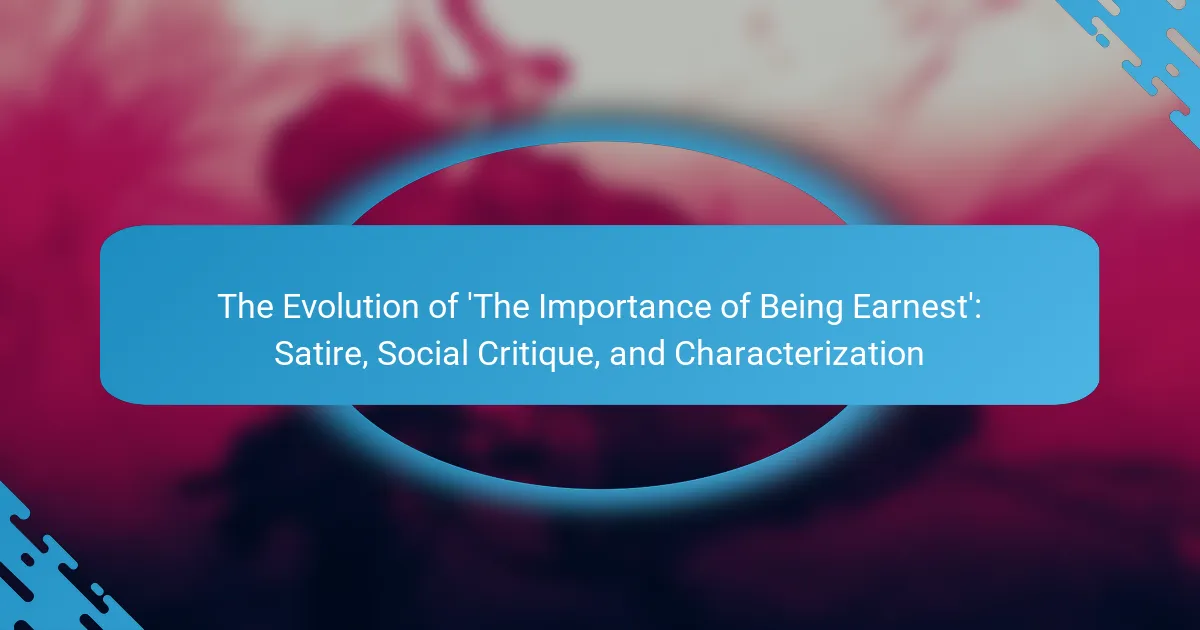The article explores Tennessee Williams’ play “A Streetcar Named Desire,” focusing on character development, symbolism, and social commentary. Key themes such as desire, mental illness, and the conflict between reality and illusion are examined through the experiences of characters like Blanche DuBois, Stanley Kowalski, and Stella. The play reflects societal values of post-war America, highlighting the tension between traditional and modern ideals. Techniques employed by Williams, including dialogue, symbolism, and vivid imagery, are analyzed to understand how they enhance the emotional depth and thematic complexity of the narrative. Overall, the article provides a comprehensive analysis of the intricate interplay between characters, themes, and societal context in the play.

What are the key themes in ‘A Streetcar Named Desire’?
The key themes in ‘A Streetcar Named Desire’ include desire, mental illness, and the clash between reality and illusion. Desire drives the characters’ actions and ultimately leads to their downfall. Mental illness is portrayed through Blanche’s deteriorating psyche and her inability to cope with reality. The conflict between reality and illusion is evident in Blanche’s attempts to create a false persona. This theme highlights the struggle for identity and acceptance in a harsh world. The characters’ interactions reveal societal norms and the impact of gender roles. Overall, these themes intertwine to explore human fragility and resilience.
How does character development shape the narrative?
Character development shapes the narrative by influencing plot progression and emotional engagement. In “A Streetcar Named Desire,” the evolution of characters like Blanche DuBois and Stanley Kowalski drives the story forward. Their interactions reveal underlying themes of desire, power, and vulnerability. For example, Blanche’s tragic backstory and mental decline create tension and empathy. Similarly, Stanley’s assertive nature contrasts with Blanche’s fragility, highlighting social dynamics. This character interplay not only propels the narrative but also deepens the audience’s understanding of the characters’ motivations and conflicts. The complexity of their development enriches the overall story, making it a compelling exploration of human experience.
What are the main characters and their roles in the story?
The main characters in “A Streetcar Named Desire” are Blanche DuBois, Stanley Kowalski, and Stella Kowalski. Blanche DuBois is the tragic protagonist who represents fragility and the decline of Southern gentility. She seeks refuge in her sister’s home and struggles with her past traumas. Stanley Kowalski is the antagonist, embodying raw masculinity and the harsh realities of life. He clashes with Blanche, ultimately leading to her downfall. Stella Kowalski is caught between her sister and her husband, representing loyalty and the complexities of love. These characters drive the narrative and highlight themes of desire, conflict, and the struggle for identity.
How do the characters evolve throughout the play?
The characters in “A Streetcar Named Desire” evolve through their interactions and personal struggles. Blanche DuBois begins as a fragile, delusional woman seeking refuge. Her past traumas and mental instability gradually surface, leading to her tragic downfall. Stanley Kowalski starts as a dominant, confident figure. His aggressive nature intensifies as he confronts Blanche, ultimately exposing her vulnerabilities. Stella Kowalski evolves from a passive character to someone who must choose between her sister and her husband. This choice reflects her internal conflict and growth throughout the play. Each character’s evolution is marked by their responses to conflict and their relationships with one another, highlighting themes of desire, reality, and social dynamics.
What symbolism is present in ‘A Streetcar Named Desire’?
‘A Streetcar Named Desire’ contains rich symbolism that enhances its themes. The streetcar itself symbolizes desire and the journey of life. It represents the characters’ pursuit of their desires, often leading to their downfall. Blanche DuBois symbolizes fragility and the decline of the Old South. Her reliance on illusion signifies her inability to cope with reality. The color white, associated with Blanche, symbolizes purity but also her deceptive nature. The paper lantern she uses represents her attempts to soften harsh truths. The setting of New Orleans symbolizes a clash between old and new values. Each symbol reinforces the characters’ struggles and societal changes.
What are the significant symbols and their meanings?
The significant symbols in “A Streetcar Named Desire” include the paper lantern, the streetcar, and the blue piano. The paper lantern represents Blanche’s desire to soften reality and hide her aging. It symbolizes her fragility and the façade she maintains to cope with her past. The streetcar signifies the journey of life and desire, illustrating the characters’ paths and their struggles. The blue piano embodies the emotional undercurrents of the play, reflecting the characters’ inner turmoil and longing. Each symbol contributes to the overall themes of illusion, desire, and the harshness of reality.
How does symbolism enhance the themes of the play?
Symbolism enhances the themes of the play by providing deeper meaning to characters and events. In “A Streetcar Named Desire,” symbols such as the streetcar itself represent desire and the journey of life. The paper lantern symbolizes Blanche’s fragile mental state and her attempts to soften harsh realities. Additionally, the color white is used to symbolize purity, which contrasts with Blanche’s troubled past. These symbols reinforce themes of illusion versus reality and the destructive nature of desire. The use of symbolism allows the audience to engage with complex emotional and social issues presented in the play.
What social commentary is reflected in the play?
The play “A Streetcar Named Desire” reflects social commentary on class struggle and gender roles. It illustrates the tension between old Southern aristocracy and the emerging working class. The character of Blanche DuBois symbolizes the decline of traditional values. In contrast, Stanley Kowalski represents raw, modern masculinity and practicality. The play critiques the fragility of human dignity in the face of societal change. It also explores the impact of mental health and trauma on individuals. The interactions between characters highlight issues of power and vulnerability. Overall, the play serves as a lens to examine post-war American society.
How does the setting influence the social dynamics portrayed?
The setting of “A Streetcar Named Desire” significantly influences the social dynamics portrayed. The story is set in New Orleans, a vibrant city with a complex social structure. This environment fosters a clash between different social classes. Blanche DuBois represents the old Southern aristocracy, while Stanley Kowalski embodies the new working class. Their interactions highlight the tensions between these social groups. The physical space of the Kowalski apartment also reflects their intimate yet oppressive relationship. The close quarters amplify conflicts and power struggles. This setting creates a backdrop for themes of desire, decay, and social change. The unique cultural atmosphere of New Orleans further enhances the characters’ emotional states and conflicts.
What issues of class and gender are addressed in the narrative?
The narrative addresses issues of class disparity and gender roles. The character of Blanche DuBois exemplifies the struggles of a declining social class. Her aristocratic background contrasts sharply with the working-class environment of New Orleans. This class conflict highlights the tension between old money and new money. Gender is depicted through the power dynamics between male and female characters. Stanley Kowalski represents brute masculinity and dominance. In contrast, Blanche embodies fragility and vulnerability. The narrative critiques societal expectations of women, showcasing their limited roles. These themes are woven into the characters’ interactions and conflicts throughout the play.
How do character interactions illustrate broader themes?
Character interactions in “A Streetcar Named Desire” illustrate broader themes such as desire, class struggle, and mental health. These interactions reveal the complexities of human relationships and societal pressures. For instance, the dynamic between Blanche and Stanley highlights the conflict between old and new social orders. Blanche represents the fading Southern gentility, while Stanley embodies the emerging working-class values. Their confrontations expose themes of power, dominance, and vulnerability. Additionally, the interactions between Stella and Stanley showcase the theme of dependency and the complexities of love. Stella’s choice to remain with Stanley despite his abusive behavior reflects the struggle between personal desire and societal expectations. These character interactions serve as a lens through which the audience can explore the underlying themes of the play.
What impact does the play have on contemporary audiences?
The play “A Streetcar Named Desire” profoundly impacts contemporary audiences by addressing themes of mental health, gender roles, and societal expectations. It challenges viewers to confront the complexities of human relationships. The portrayal of Blanche DuBois highlights the stigma surrounding mental illness, prompting discussions on psychological well-being. Additionally, the play critiques traditional gender dynamics, showcasing the struggles women face in a patriarchal society. This relevance resonates with modern audiences, who grapple with similar issues today. The emotional depth and moral ambiguity of the characters foster empathy and reflection. Overall, the play serves as a catalyst for dialogue on pressing social issues, making it a timeless piece in contemporary theatre.

How do the characters in ‘A Streetcar Named Desire’ represent different societal values?
The characters in ‘A Streetcar Named Desire’ embody various societal values reflecting post-war America. Blanche DuBois represents the fading aristocracy and traditional values, emphasizing refinement and sensitivity. Her tragic downfall illustrates the clash between old-world values and modern realities. Stanley Kowalski symbolizes the raw, primal force of the new working class. He embodies masculinity, power, and practicality, often clashing with Blanche’s ideals. Stella, caught between these two worlds, represents compromise and the struggle for stability. Her choice to remain with Stanley highlights the acceptance of contemporary societal norms over outdated traditions. Each character’s conflict underscores the tension between differing values during the era.
What values do the main characters embody?
The main characters in “A Streetcar Named Desire” embody values such as desire, vulnerability, and resilience. Blanche DuBois represents the value of desire, seeking love and acceptance despite her tragic past. Stanley Kowalski embodies raw masculinity and primal instincts, highlighting the value of power and dominance. Stella Kowalski reflects loyalty and the complexities of love, often caught between her sister and her husband. Each character’s journey illustrates their struggle with these values in a changing social landscape. Their interactions reveal deeper themes of class conflict, mental health, and the fragility of human connections. These values manifest through their choices and consequences throughout the narrative.
How do Blanche’s ideals contrast with Stanley’s pragmatism?
Blanche’s ideals represent a romanticized view of life that emphasizes beauty, illusion, and sensitivity. In contrast, Stanley’s pragmatism is grounded in realism, practicality, and raw survival instincts. Blanche clings to her past and seeks refuge in fantasy, as seen in her desire for a world filled with gentility and charm. Stanley, on the other hand, embodies a straightforward approach to life, focusing on tangible realities and immediate needs. This is evident in his interactions with others, where he prioritizes power and control. Their conflicting perspectives lead to tension, as Blanche’s delicate nature clashes with Stanley’s brute force. Ultimately, Blanche’s downfall is precipitated by Stanley’s refusal to indulge her illusions, highlighting the stark divide between idealism and pragmatism.
What does Stella’s role reveal about loyalty and compromise?
Stella’s role reveals that loyalty often requires compromise. She remains devoted to Stanley despite his abusive behavior. This loyalty highlights the conflict between personal happiness and marital commitment. Stella compromises her own well-being to maintain her relationship. Her choice reflects societal expectations of women during that era. The tension in her character illustrates the struggle between love and self-preservation. Ultimately, Stella’s actions show that loyalty can come at a significant personal cost.
How do the characters’ backstories influence their actions?
The characters’ backstories significantly influence their actions throughout “A Streetcar Named Desire.” Each character’s history shapes their motivations and responses to conflict. For instance, Blanche DuBois’s traumatic past leads her to seek validation through romantic relationships. This need drives her to manipulate others, resulting in her eventual downfall. Stanley Kowalski’s working-class background instills a sense of dominance and entitlement. His actions toward Blanche reflect his desire to assert control over his environment. Additionally, Stella’s choice to remain with Stanley despite his flaws reveals her struggle between love and loyalty, influenced by her past experiences. These interconnected backstories create a complex web of motivations that drive the narrative forward.
What traumatic experiences shape Blanche’s character?
Blanche’s character is shaped by several traumatic experiences. The death of her young husband profoundly impacts her psyche. She discovers his homosexuality and subsequent suicide, leading to deep guilt and shame. Blanche also faces the loss of her family estate, Belle Reeve, which symbolizes her fading social status. Additionally, her numerous failed relationships contribute to her emotional instability. These traumas culminate in her reliance on illusions to cope with reality. Blanche’s mental deterioration is evident throughout the play, highlighting the effects of her past.
How does Stanley’s background inform his behavior?
Stanley’s background as a working-class individual informs his behavior through a strong sense of masculinity and dominance. Raised in a Polish immigrant family, he embodies the values of hard work and assertiveness. His blue-collar upbringing shapes his worldview, leading him to prioritize practicality over sentimentality. This background fosters a competitive nature, evident in his interactions with others. Stanley’s lack of formal education contributes to his reliance on physicality and instinct in conflict resolution. His behavior reflects a desire to assert control in his domestic environment. This need for dominance is particularly pronounced in his relationship with Stella and Blanche. Overall, Stanley’s background deeply influences his aggressive and confrontational demeanor throughout the play.

What techniques does Tennessee Williams use to convey character and theme?
Tennessee Williams employs various techniques to convey character and theme in his works. He utilizes dialogue to reveal character motivations and conflicts. The characters often express their inner thoughts through poetic language. This technique adds depth to their personalities and highlights their emotional struggles.
Williams also uses symbolism extensively to enhance themes. Objects like the paper lantern in “A Streetcar Named Desire” symbolize fragility and the desire to mask reality. Additionally, the setting plays a crucial role in reflecting characters’ states of mind. For example, the New Orleans backdrop emphasizes the clash between old and new values.
Moreover, Williams incorporates vivid imagery to evoke emotions and convey themes of desire and despair. The use of music and sound further amplifies the emotional landscape of his plays. These techniques collectively deepen the audience’s understanding of the characters and the overarching themes.
How does dialogue contribute to character development?
Dialogue significantly contributes to character development by revealing motivations and emotions. Characters express their thoughts and feelings through spoken words. This allows the audience to understand their inner conflicts and desires. In “A Streetcar Named Desire,” for example, Blanche’s dialogue reflects her vulnerability and past trauma. Her speech patterns and word choices highlight her fragility. Additionally, Stanley’s assertive dialogue showcases his dominance and contrasting nature. The exchanges between characters build tension and deepen their relationships. Through dialogue, playwright Tennessee Williams crafts complex characters that evolve throughout the narrative. This technique enhances the audience’s connection to the characters’ journeys.
What are some key lines that reveal character motivations?
Key lines that reveal character motivations in “A Streetcar Named Desire” include Blanche’s statement, “I don’t want realism. I want magic.” This line illustrates her desire to escape harsh realities. Stanley’s declaration, “Every man is a king!” highlights his assertiveness and need for control. Stella’s line, “I am not in anything I want to get out of,” shows her commitment to her relationship with Stanley despite its flaws. These lines provide insight into the characters’ inner drives and conflicts. Blanche seeks refuge in fantasy, Stanley asserts dominance, and Stella prioritizes love over stability. Each line encapsulates their motivations and shapes the narrative’s emotional landscape.
How does subtext play a role in character interactions?
Subtext significantly influences character interactions by conveying underlying emotions and motivations. Characters often express feelings indirectly, leading to deeper insights into their relationships. For example, in “A Streetcar Named Desire,” Blanche’s delicate language contrasts with her turbulent past. This contrast highlights her fragility and desperation for acceptance. Similarly, Stanley’s aggressive demeanor masks insecurities about his status. The tension between their interactions reveals power dynamics and emotional struggles. Subtext enriches dialogue, allowing audiences to grasp complex character layers. Thus, subtext serves as a crucial tool for understanding character motivations and the nuances of their relationships.
What role does stage direction play in the storytelling?
Stage direction plays a crucial role in storytelling by guiding actors’ movements and enhancing narrative clarity. It provides context for the emotional tone and physical dynamics of scenes. In “A Streetcar Named Desire,” stage directions reveal character relationships and inner conflicts. For instance, they illustrate Blanche’s fragility and Stanley’s dominance through their physical interactions. This visual representation deepens audience understanding of character motivations. Additionally, stage directions help establish the setting, creating an atmosphere that supports the themes of the play. The specificity of directions can evoke particular responses from the audience, influencing their interpretation of the story. Overall, stage direction is integral to conveying the playwright’s vision and enriching the storytelling experience.
How do visual elements enhance the emotional impact of the play?
Visual elements enhance the emotional impact of the play by creating a vivid atmosphere. They engage the audience’s senses and evoke feelings that align with the narrative. For instance, lighting can set the mood, transitioning from bright to dim to reflect tension. Set design, including props and backgrounds, provides context that deepens character emotions. Costumes can symbolize personal struggles and social status, influencing audience perception. Color schemes can evoke specific emotions, such as warmth or despair. These elements work together to create a cohesive experience that resonates emotionally with viewers. Research shows that visual stimuli significantly affect emotional responses in theater, reinforcing the connection between visuals and audience engagement.
What is the significance of the play’s setting in New Orleans?
The significance of the play’s setting in New Orleans is profound. New Orleans represents a vibrant cultural backdrop that influences the characters’ lives. The city’s unique blend of Creole, African, and European cultures shapes the social dynamics in the play. This setting enhances themes of desire and decay. The heat and humidity of New Orleans create an oppressive atmosphere reflecting the characters’ emotional states. The setting also symbolizes the clash between old-world gentility and modern realities. It serves as a microcosm of post-war American society. The local color and rhythms of the city contribute to the play’s overall mood and tension.
What lessons can be learned from ‘A Streetcar Named Desire’?
‘A Streetcar Named Desire’ teaches lessons about the fragility of human dignity and the impact of mental health. The character Blanche DuBois embodies the struggle against societal norms and personal trauma. Her descent into madness illustrates the consequences of unresolved emotional pain. The play highlights the clash between reality and illusion. It shows how individuals cope with loss and the need for acceptance. The interactions between characters reveal the complexities of relationships and power dynamics. Ultimately, the narrative underscores the importance of compassion and understanding in human interactions. These themes remain relevant in contemporary discussions about mental health and social acceptance.
How can modern audiences relate to the characters’ struggles?
Modern audiences can relate to the characters’ struggles through shared human experiences. The characters in ‘A Streetcar Named Desire’ face issues like mental health, desire, and societal pressure. These themes resonate with contemporary challenges. For example, Blanche’s battle with trauma reflects the ongoing conversations about mental health today. Additionally, Stanley’s assertiveness and desire for control symbolize toxic masculinity, a relevant topic in modern discussions. The characters’ complex relationships mirror the struggles many face in personal and familial dynamics. Their quests for identity and belonging are universal, making their experiences relatable across generations.
What insights does the play offer about human relationships?
The play “A Streetcar Named Desire” offers profound insights into human relationships, highlighting the complexities of desire, vulnerability, and power dynamics. It explores how characters navigate their emotional needs and the consequences of their actions. The interactions between Blanche, Stanley, and Stella reveal the tension between illusion and reality. Blanche’s dependence on others showcases her vulnerability and the impact of past traumas on her relationships. Stanley’s assertiveness reflects a struggle for control, emphasizing themes of masculinity. Stella’s conflict between her love for Stanley and her loyalty to Blanche illustrates the challenges of familial bonds. The play ultimately suggests that human relationships are often fraught with misunderstandings and the struggle for connection amidst personal struggles.
The main entity of the article is “A Streetcar Named Desire,” a play by Tennessee Williams. The article explores key themes such as desire, mental illness, and the conflict between reality and illusion, highlighting character development and interactions that drive the narrative. It examines the symbolism present in the play, including significant objects and their meanings, while also addressing social commentary on class struggle and gender roles. Additionally, the article discusses how character backstories influence actions and the techniques Williams employs to convey character and theme, providing insights into human relationships and their relevance to contemporary audiences.


